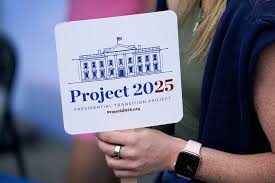Six Sleeper Proposals in Project 2025
Legal Planet: Environmental Law and Policy 2024-10-24

The Project 2025 report is 920 pages long, but only a few portions have gotten much public attention. The report’s significance is precisely that it goes beyond a few headline proposals to set a comprehensive agenda for a second Trump Administration. There are dozens of significant proposals relating to energy and the environment. Although I can’t talk about all of them here, I want to flag a few of these sleeper provisions.
But does Project 2025 even matter, you might ask? It’s true that Trump disavowed the report. Yet it comes with the imprimatur of a host of conservative organizations and involves many people with ties to Trump. It also echoes Trump’s priorities.
With all that in mind, here are six Project 2025 proposals that you probably haven’t heard much about. They involve reduced protection for endangered species, eliminating energy efficiency rules, blocking new transmission lines, changing electricity regulation to favor fossil fuels, weakening air pollution rules, and encouraging sale of gas guzzlers.
#1. Undermining endangered species protections.
Project 2025 portrays the Fish & Wildlife Service as “the work of the Fish and Wildlife Service is the product of ‘species cartels’ afflicted with group think, confirmation bias, and a common desire to preserve the prestige, power, and appropriations of the agency that pays or employs them.” (Obviously they couldn’t just be underpaid public servants doing their best to implement the law.) In any event, the solution is to “reform” the Endangered Species Act so that it won’t stand in the way of real estate interests or economic development, by “restoring the rights of states over their wildlife populations” and ensuring that species preservation will take the backseat to development interests. Short of congressional action, the report advocates a bevy of administrative changes to weaken endangered species protections. [pp. 633-634]
#2. Axing energy efficiency programs.
Project 2025 explains the Department of Energy’s energy efficiency programs very clearly: “Pursuant to the Energy Policy and Conservation Act of 1975 as amended, the agency is required to set and periodically tighten energy and/or water efficiency standards for nearly all kinds of commercial and household appliances, including air conditioners, furnaces, water heaters, stoves, clothes washers and dryers, refrigerators, dishwashers, light bulbs, and showerheads.” [pp. 378-379] Those standards save the average household about $320 per year. Given that there are about 130 million U.S. households, this means total consumer savings from DOE standards are around $46 billion a year. Project 2025 is opposed to those consumer savings, apparently.
#3. Stymying new transmission lines.
Congress and FERC have both taken actions to expand the transmission, especially the big lines needed to redistribute energy generated in one state to users in other states. Since expanding would help even out fluctuations in local renewable energy generation, Project 2025 hates the whole idea. Letting more wind farms in Iowa sell electricity to Ohio, and the like, would make it “less economical” for “coal, nuclear, and natural gas to stay operational.” [pp. 404-406] That’s because the renewables would be cheaper. Despite Project 2025’s repeated references to grid reliability, the issue falls to the wayside when improving reliability would go hand in hand with expanded use of renewables. This is understandable given the report’s zeal for “American energy dominance” – Trumpian code for producing and using as much fossil fuel as humanly possible.
#4. Abolish energy markets or adjust them to favor fossil fuels.
Conservatives used to believe in the free market, but Project 2025 seems quite skeptical of the idea of competitive electricity markets. It complains that, just as in ordinary product markets, the price is set by the most expensive producer in the market, rewarding those with cheaper production. Project 2025 views this as a bad idea because renewable generation gets to charge the same price as natural gas generators, which are pricier. The deeper problem, according to Project 2025, is with having competitive markets at all, as opposed to the more traditional scheme where utilities are controlled by state public utility commissions. [pp. 403-404] Short of returning to the good old days of monopolistic utilities, FERC should adjust prices to disfavor renewables because of their supposed lack of reliability. That will have what the report considers to be the happy consequence of giving fossil fuels an economic edge. [pp. 402-404]
#5. Crippling air pollution control.
Given its passion for fossil fuels, it shouldn’t be a surprise that Project 2025 takes a dim view of pollution control. Consequently, it has a series of proposals to weaken limits on air pollution, especially from power plants, refineries, and cars. In general, Project 2025 maintains, “EPA’s structure and mission should be greatly circumscribed.” [p. 420] Specifically, the report calls for weakening protections against interstate air pollution [pp. 424-425] and toxic air pollution [427].
#6. Embracing gas guzzlers.
Project 2025 calls for rolling back CAFÉ fuel efficiency standards to 2020 levels (35 mpg). Those standards are issued by the Department of Transportation. Since a 2007 Supreme Court decision, EPA has been charged with issuing CO2 standards for cars and trucks, which in effect require less fuel use. Project 2025 wants to change this. Standards for cars should be set by the Department of Transportation alone; EPA should limit itself to regulating emissions from automobile air conditioning systems. California should not be allowed to limit CO2 from cars either. [pp. 627-629] And the federal government should stop funding mass transit. [p. 636] I probably missed it, but I didn’t notice any reference to the fact that cars and trucks cause pollution.